Comparative Analysis: Pricing Policies of HP Touchpad and Apple iPad
VerifiedAdded on 2022/09/09
|13
|2342
|34
Report
AI Summary
This report delves into the pricing policies employed by Hewlett-Packard (HP) and Apple, specifically within the context of the tablet market. It begins with an overview of pricing strategies, highlighting the importance of considering factors such as growth targets, brand positioning, and external variables like customer demand and competition. The report then examines specific pricing methods, including cost-plus pricing and its limitations, as well as target costing. A detailed analysis of HP's pricing strategies for its Touchpad tablet, including promotional and bundling strategies and market segmentation approaches, is presented. Furthermore, the report explores Apple's pricing methods, such as penetration pricing, skimming pricing, and discounted pricing, and how these strategies have evolved over time to maintain a competitive edge in the market. The conclusion emphasizes the critical role of effective pricing strategies in achieving market success, drawing comparisons between the approaches of HP and Apple.

Pricing Policies
1
1
Paraphrase This Document
Need a fresh take? Get an instant paraphrase of this document with our AI Paraphraser

Jumana Mohammed Al-Habsi
ST08635
2
ST08635
2
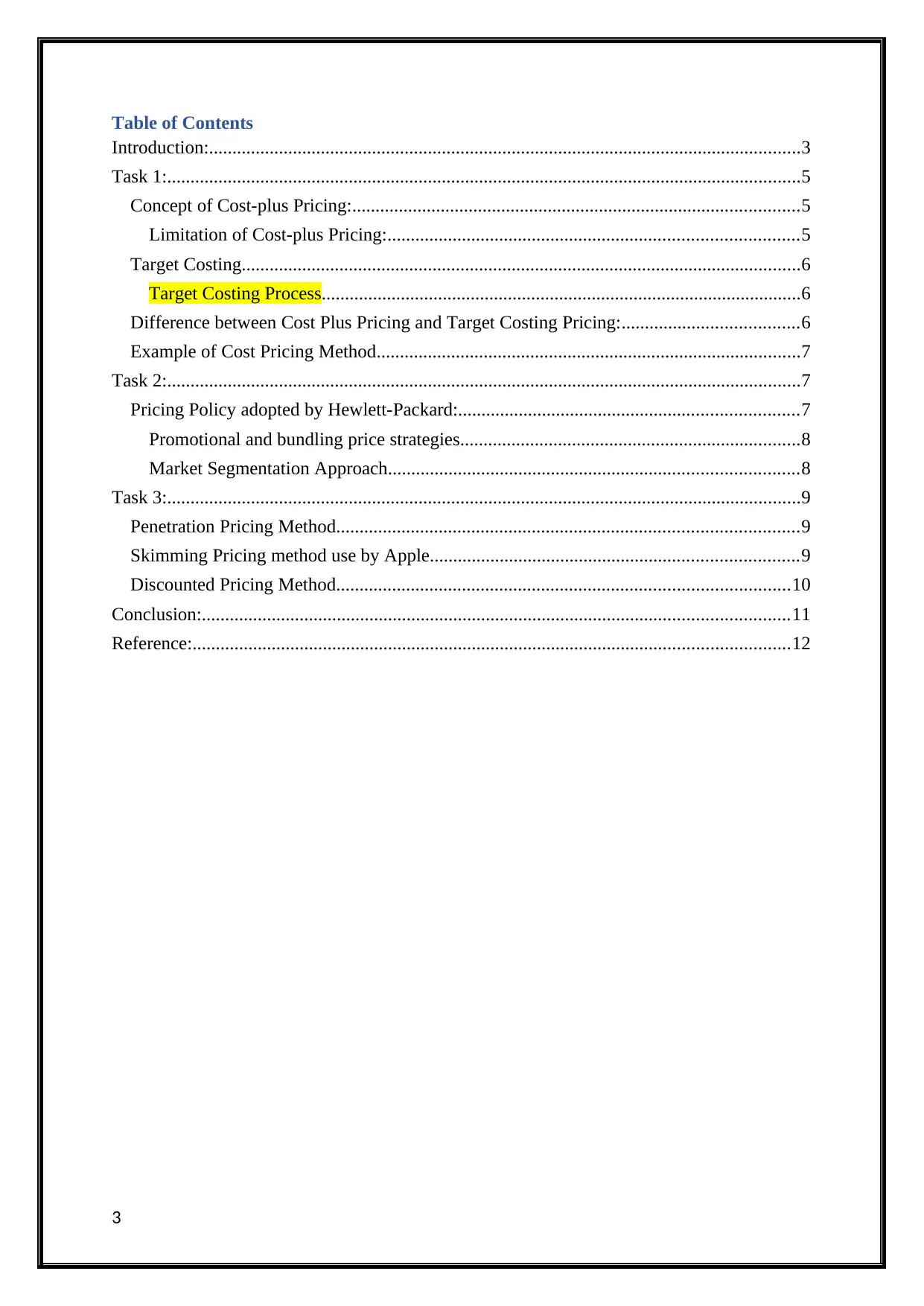
Table of Contents
Introduction:...............................................................................................................................3
Task 1:........................................................................................................................................5
Concept of Cost-plus Pricing:................................................................................................5
Limitation of Cost-plus Pricing:........................................................................................5
Target Costing........................................................................................................................6
Target Costing Process.......................................................................................................6
Difference between Cost Plus Pricing and Target Costing Pricing:......................................6
Example of Cost Pricing Method...........................................................................................7
Task 2:........................................................................................................................................7
Pricing Policy adopted by Hewlett-Packard:.........................................................................7
Promotional and bundling price strategies.........................................................................8
Market Segmentation Approach........................................................................................8
Task 3:........................................................................................................................................9
Penetration Pricing Method...................................................................................................9
Skimming Pricing method use by Apple...............................................................................9
Discounted Pricing Method.................................................................................................10
Conclusion:..............................................................................................................................11
Reference:................................................................................................................................12
3
Introduction:...............................................................................................................................3
Task 1:........................................................................................................................................5
Concept of Cost-plus Pricing:................................................................................................5
Limitation of Cost-plus Pricing:........................................................................................5
Target Costing........................................................................................................................6
Target Costing Process.......................................................................................................6
Difference between Cost Plus Pricing and Target Costing Pricing:......................................6
Example of Cost Pricing Method...........................................................................................7
Task 2:........................................................................................................................................7
Pricing Policy adopted by Hewlett-Packard:.........................................................................7
Promotional and bundling price strategies.........................................................................8
Market Segmentation Approach........................................................................................8
Task 3:........................................................................................................................................9
Penetration Pricing Method...................................................................................................9
Skimming Pricing method use by Apple...............................................................................9
Discounted Pricing Method.................................................................................................10
Conclusion:..............................................................................................................................11
Reference:................................................................................................................................12
3
⊘ This is a preview!⊘
Do you want full access?
Subscribe today to unlock all pages.

Trusted by 1+ million students worldwide
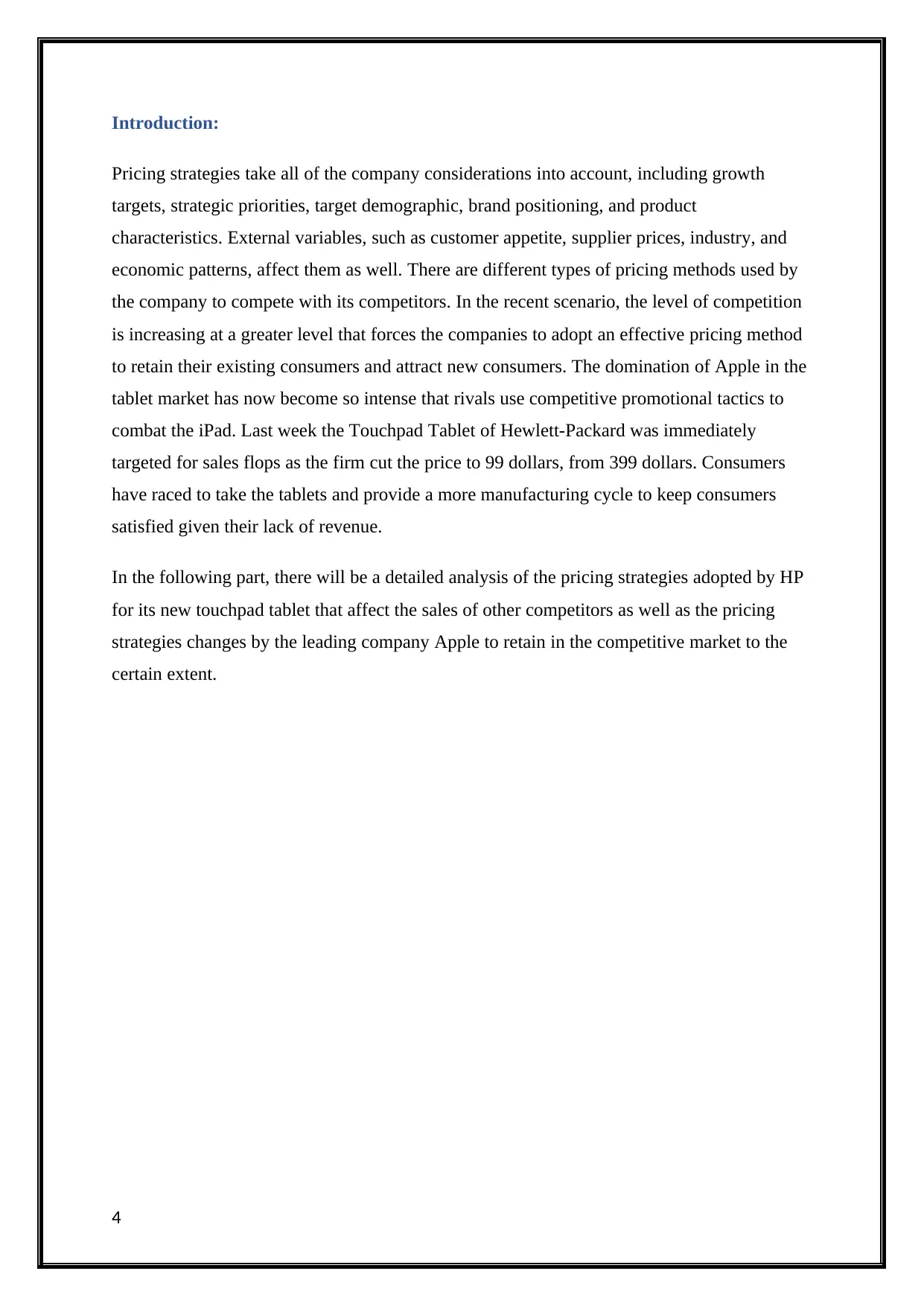
Introduction:
Pricing strategies take all of the company considerations into account, including growth
targets, strategic priorities, target demographic, brand positioning, and product
characteristics. External variables, such as customer appetite, supplier prices, industry, and
economic patterns, affect them as well. There are different types of pricing methods used by
the company to compete with its competitors. In the recent scenario, the level of competition
is increasing at a greater level that forces the companies to adopt an effective pricing method
to retain their existing consumers and attract new consumers. The domination of Apple in the
tablet market has now become so intense that rivals use competitive promotional tactics to
combat the iPad. Last week the Touchpad Tablet of Hewlett-Packard was immediately
targeted for sales flops as the firm cut the price to 99 dollars, from 399 dollars. Consumers
have raced to take the tablets and provide a more manufacturing cycle to keep consumers
satisfied given their lack of revenue.
In the following part, there will be a detailed analysis of the pricing strategies adopted by HP
for its new touchpad tablet that affect the sales of other competitors as well as the pricing
strategies changes by the leading company Apple to retain in the competitive market to the
certain extent.
4
Pricing strategies take all of the company considerations into account, including growth
targets, strategic priorities, target demographic, brand positioning, and product
characteristics. External variables, such as customer appetite, supplier prices, industry, and
economic patterns, affect them as well. There are different types of pricing methods used by
the company to compete with its competitors. In the recent scenario, the level of competition
is increasing at a greater level that forces the companies to adopt an effective pricing method
to retain their existing consumers and attract new consumers. The domination of Apple in the
tablet market has now become so intense that rivals use competitive promotional tactics to
combat the iPad. Last week the Touchpad Tablet of Hewlett-Packard was immediately
targeted for sales flops as the firm cut the price to 99 dollars, from 399 dollars. Consumers
have raced to take the tablets and provide a more manufacturing cycle to keep consumers
satisfied given their lack of revenue.
In the following part, there will be a detailed analysis of the pricing strategies adopted by HP
for its new touchpad tablet that affect the sales of other competitors as well as the pricing
strategies changes by the leading company Apple to retain in the competitive market to the
certain extent.
4
Paraphrase This Document
Need a fresh take? Get an instant paraphrase of this document with our AI Paraphraser
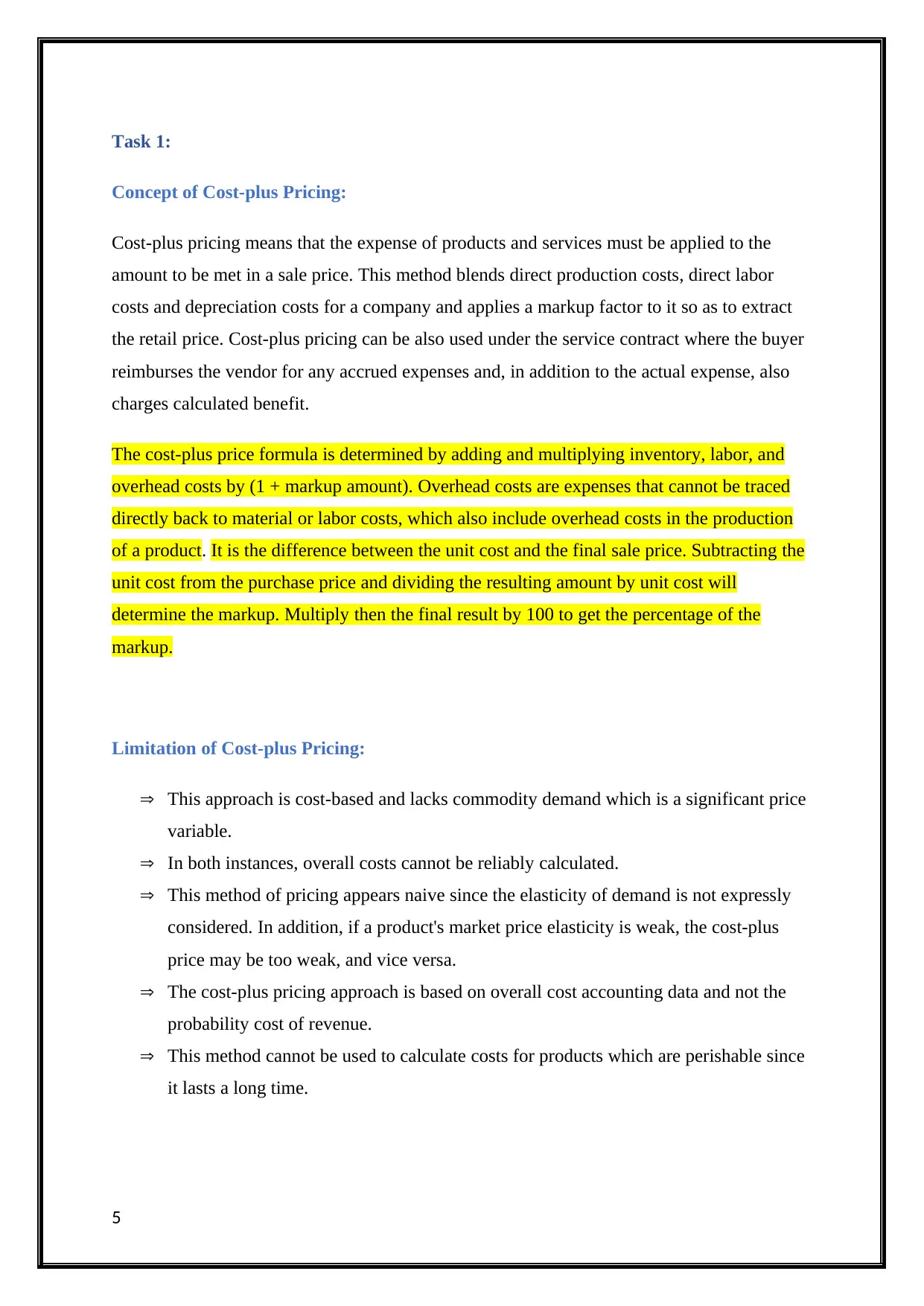
Task 1:
Concept of Cost-plus Pricing:
Cost-plus pricing means that the expense of products and services must be applied to the
amount to be met in a sale price. This method blends direct production costs, direct labor
costs and depreciation costs for a company and applies a markup factor to it so as to extract
the retail price. Cost-plus pricing can be also used under the service contract where the buyer
reimburses the vendor for any accrued expenses and, in addition to the actual expense, also
charges calculated benefit.
The cost-plus price formula is determined by adding and multiplying inventory, labor, and
overhead costs by (1 + markup amount). Overhead costs are expenses that cannot be traced
directly back to material or labor costs, which also include overhead costs in the production
of a product. It is the difference between the unit cost and the final sale price. Subtracting the
unit cost from the purchase price and dividing the resulting amount by unit cost will
determine the markup. Multiply then the final result by 100 to get the percentage of the
markup.
Limitation of Cost-plus Pricing:
This approach is cost-based and lacks commodity demand which is a significant price
variable.
In both instances, overall costs cannot be reliably calculated.
This method of pricing appears naive since the elasticity of demand is not expressly
considered. In addition, if a product's market price elasticity is weak, the cost-plus
price may be too weak, and vice versa.
The cost-plus pricing approach is based on overall cost accounting data and not the
probability cost of revenue.
This method cannot be used to calculate costs for products which are perishable since
it lasts a long time.
5
Concept of Cost-plus Pricing:
Cost-plus pricing means that the expense of products and services must be applied to the
amount to be met in a sale price. This method blends direct production costs, direct labor
costs and depreciation costs for a company and applies a markup factor to it so as to extract
the retail price. Cost-plus pricing can be also used under the service contract where the buyer
reimburses the vendor for any accrued expenses and, in addition to the actual expense, also
charges calculated benefit.
The cost-plus price formula is determined by adding and multiplying inventory, labor, and
overhead costs by (1 + markup amount). Overhead costs are expenses that cannot be traced
directly back to material or labor costs, which also include overhead costs in the production
of a product. It is the difference between the unit cost and the final sale price. Subtracting the
unit cost from the purchase price and dividing the resulting amount by unit cost will
determine the markup. Multiply then the final result by 100 to get the percentage of the
markup.
Limitation of Cost-plus Pricing:
This approach is cost-based and lacks commodity demand which is a significant price
variable.
In both instances, overall costs cannot be reliably calculated.
This method of pricing appears naive since the elasticity of demand is not expressly
considered. In addition, if a product's market price elasticity is weak, the cost-plus
price may be too weak, and vice versa.
The cost-plus pricing approach is based on overall cost accounting data and not the
probability cost of revenue.
This method cannot be used to calculate costs for products which are perishable since
it lasts a long time.
5
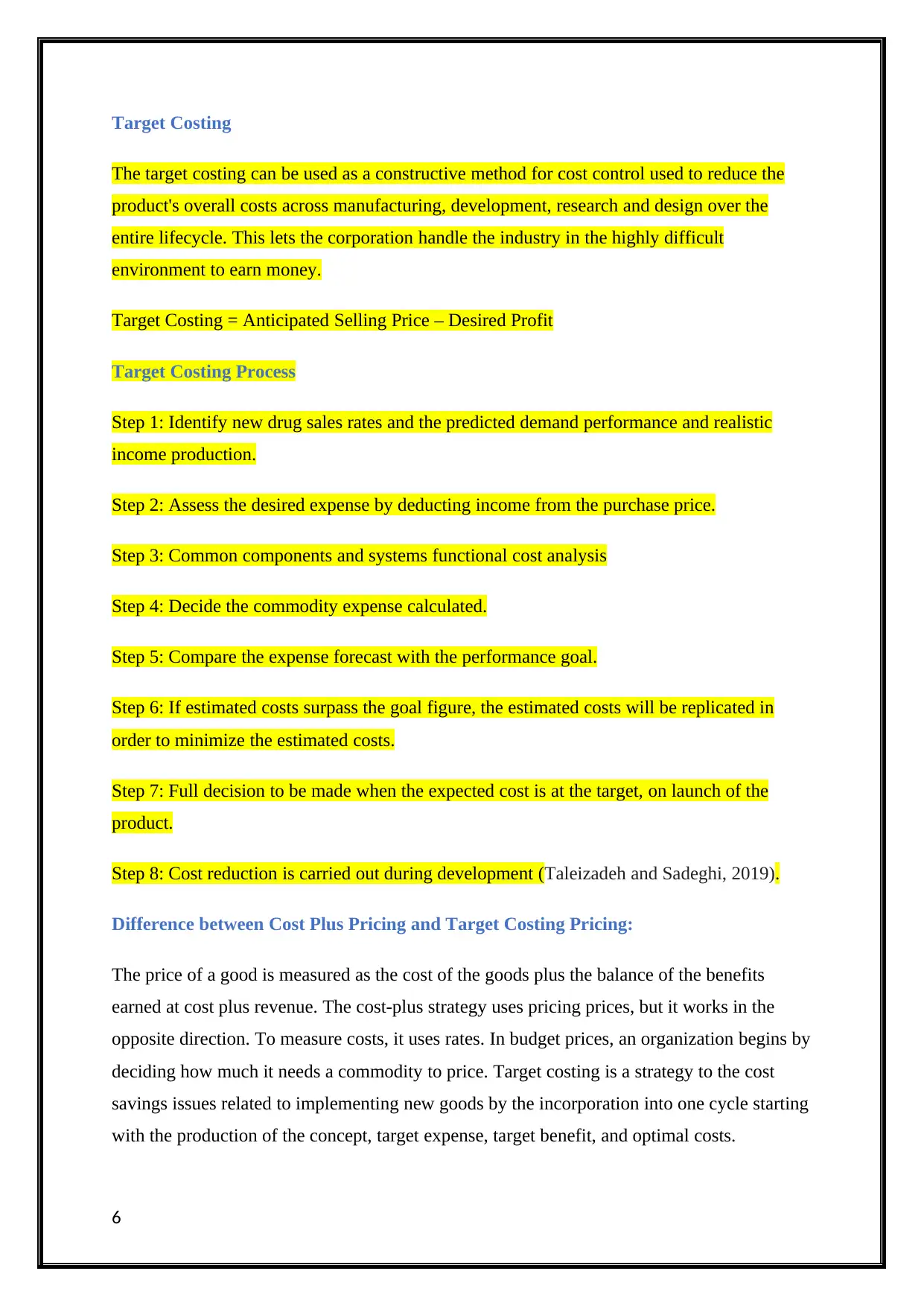
Target Costing
The target costing can be used as a constructive method for cost control used to reduce the
product's overall costs across manufacturing, development, research and design over the
entire lifecycle. This lets the corporation handle the industry in the highly difficult
environment to earn money.
Target Costing = Anticipated Selling Price – Desired Profit
Target Costing Process
Step 1: Identify new drug sales rates and the predicted demand performance and realistic
income production.
Step 2: Assess the desired expense by deducting income from the purchase price.
Step 3: Common components and systems functional cost analysis
Step 4: Decide the commodity expense calculated.
Step 5: Compare the expense forecast with the performance goal.
Step 6: If estimated costs surpass the goal figure, the estimated costs will be replicated in
order to minimize the estimated costs.
Step 7: Full decision to be made when the expected cost is at the target, on launch of the
product.
Step 8: Cost reduction is carried out during development (Taleizadeh and Sadeghi, 2019).
Difference between Cost Plus Pricing and Target Costing Pricing:
The price of a good is measured as the cost of the goods plus the balance of the benefits
earned at cost plus revenue. The cost-plus strategy uses pricing prices, but it works in the
opposite direction. To measure costs, it uses rates. In budget prices, an organization begins by
deciding how much it needs a commodity to price. Target costing is a strategy to the cost
savings issues related to implementing new goods by the incorporation into one cycle starting
with the production of the concept, target expense, target benefit, and optimal costs.
6
The target costing can be used as a constructive method for cost control used to reduce the
product's overall costs across manufacturing, development, research and design over the
entire lifecycle. This lets the corporation handle the industry in the highly difficult
environment to earn money.
Target Costing = Anticipated Selling Price – Desired Profit
Target Costing Process
Step 1: Identify new drug sales rates and the predicted demand performance and realistic
income production.
Step 2: Assess the desired expense by deducting income from the purchase price.
Step 3: Common components and systems functional cost analysis
Step 4: Decide the commodity expense calculated.
Step 5: Compare the expense forecast with the performance goal.
Step 6: If estimated costs surpass the goal figure, the estimated costs will be replicated in
order to minimize the estimated costs.
Step 7: Full decision to be made when the expected cost is at the target, on launch of the
product.
Step 8: Cost reduction is carried out during development (Taleizadeh and Sadeghi, 2019).
Difference between Cost Plus Pricing and Target Costing Pricing:
The price of a good is measured as the cost of the goods plus the balance of the benefits
earned at cost plus revenue. The cost-plus strategy uses pricing prices, but it works in the
opposite direction. To measure costs, it uses rates. In budget prices, an organization begins by
deciding how much it needs a commodity to price. Target costing is a strategy to the cost
savings issues related to implementing new goods by the incorporation into one cycle starting
with the production of the concept, target expense, target benefit, and optimal costs.
6
⊘ This is a preview!⊘
Do you want full access?
Subscribe today to unlock all pages.

Trusted by 1+ million students worldwide
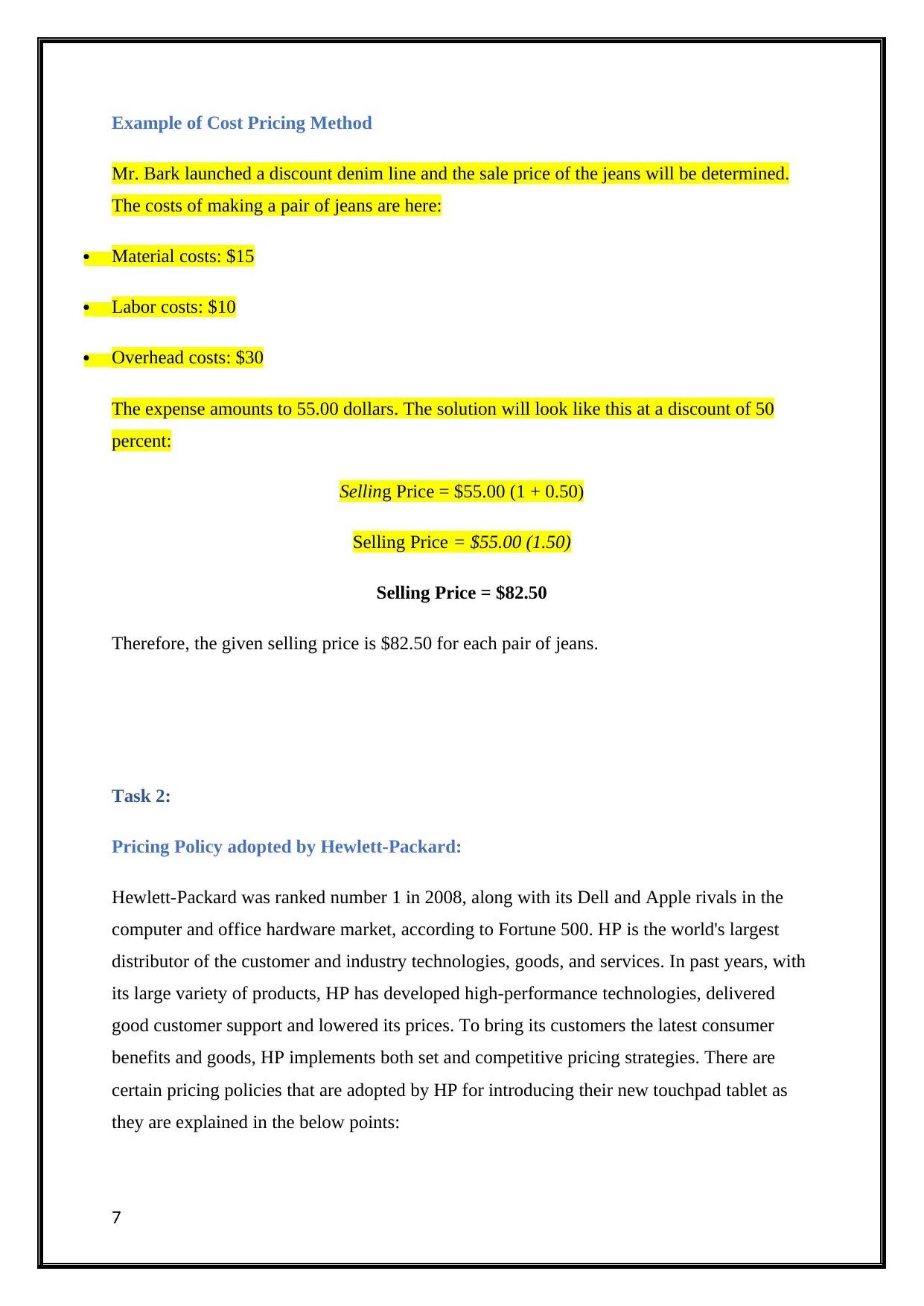
Example of Cost Pricing Method
Mr. Bark launched a discount denim line and the sale price of the jeans will be determined.
The costs of making a pair of jeans are here:
Material costs: $15
Labor costs: $10
Overhead costs: $30
The expense amounts to 55.00 dollars. The solution will look like this at a discount of 50
percent:
Selling Price = $55.00 (1 + 0.50)
Selling Price = $55.00 (1.50)
Selling Price = $82.50
Therefore, the given selling price is $82.50 for each pair of jeans.
Task 2:
Pricing Policy adopted by Hewlett-Packard:
Hewlett-Packard was ranked number 1 in 2008, along with its Dell and Apple rivals in the
computer and office hardware market, according to Fortune 500. HP is the world's largest
distributor of the customer and industry technologies, goods, and services. In past years, with
its large variety of products, HP has developed high-performance technologies, delivered
good customer support and lowered its prices. To bring its customers the latest consumer
benefits and goods, HP implements both set and competitive pricing strategies. There are
certain pricing policies that are adopted by HP for introducing their new touchpad tablet as
they are explained in the below points:
7
Mr. Bark launched a discount denim line and the sale price of the jeans will be determined.
The costs of making a pair of jeans are here:
Material costs: $15
Labor costs: $10
Overhead costs: $30
The expense amounts to 55.00 dollars. The solution will look like this at a discount of 50
percent:
Selling Price = $55.00 (1 + 0.50)
Selling Price = $55.00 (1.50)
Selling Price = $82.50
Therefore, the given selling price is $82.50 for each pair of jeans.
Task 2:
Pricing Policy adopted by Hewlett-Packard:
Hewlett-Packard was ranked number 1 in 2008, along with its Dell and Apple rivals in the
computer and office hardware market, according to Fortune 500. HP is the world's largest
distributor of the customer and industry technologies, goods, and services. In past years, with
its large variety of products, HP has developed high-performance technologies, delivered
good customer support and lowered its prices. To bring its customers the latest consumer
benefits and goods, HP implements both set and competitive pricing strategies. There are
certain pricing policies that are adopted by HP for introducing their new touchpad tablet as
they are explained in the below points:
7
Paraphrase This Document
Need a fresh take? Get an instant paraphrase of this document with our AI Paraphraser
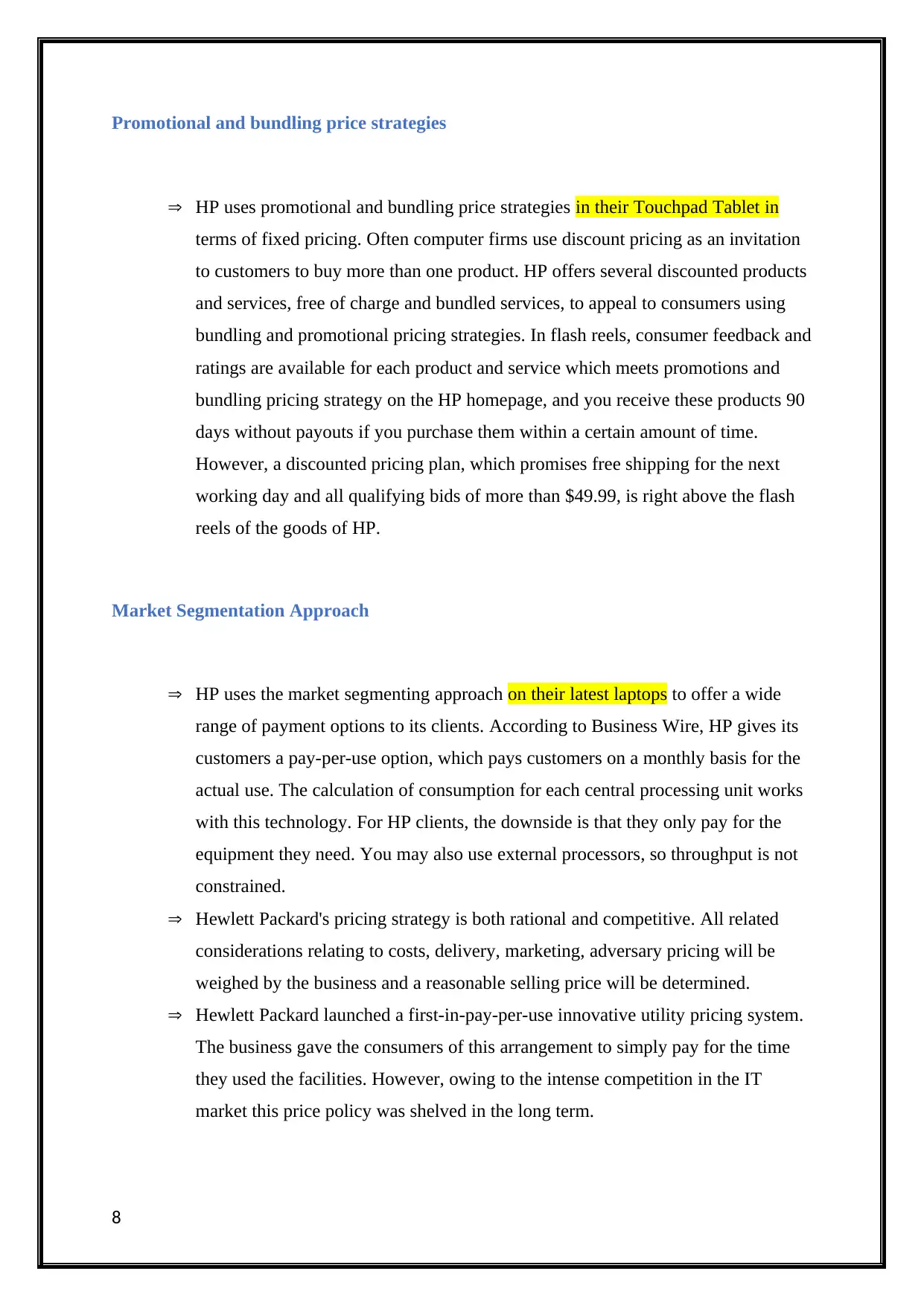
Promotional and bundling price strategies
HP uses promotional and bundling price strategies in their Touchpad Tablet in
terms of fixed pricing. Often computer firms use discount pricing as an invitation
to customers to buy more than one product. HP offers several discounted products
and services, free of charge and bundled services, to appeal to consumers using
bundling and promotional pricing strategies. In flash reels, consumer feedback and
ratings are available for each product and service which meets promotions and
bundling pricing strategy on the HP homepage, and you receive these products 90
days without payouts if you purchase them within a certain amount of time.
However, a discounted pricing plan, which promises free shipping for the next
working day and all qualifying bids of more than $49.99, is right above the flash
reels of the goods of HP.
Market Segmentation Approach
HP uses the market segmenting approach on their latest laptops to offer a wide
range of payment options to its clients. According to Business Wire, HP gives its
customers a pay-per-use option, which pays customers on a monthly basis for the
actual use. The calculation of consumption for each central processing unit works
with this technology. For HP clients, the downside is that they only pay for the
equipment they need. You may also use external processors, so throughput is not
constrained.
Hewlett Packard's pricing strategy is both rational and competitive. All related
considerations relating to costs, delivery, marketing, adversary pricing will be
weighed by the business and a reasonable selling price will be determined.
Hewlett Packard launched a first-in-pay-per-use innovative utility pricing system.
The business gave the consumers of this arrangement to simply pay for the time
they used the facilities. However, owing to the intense competition in the IT
market this price policy was shelved in the long term.
8
HP uses promotional and bundling price strategies in their Touchpad Tablet in
terms of fixed pricing. Often computer firms use discount pricing as an invitation
to customers to buy more than one product. HP offers several discounted products
and services, free of charge and bundled services, to appeal to consumers using
bundling and promotional pricing strategies. In flash reels, consumer feedback and
ratings are available for each product and service which meets promotions and
bundling pricing strategy on the HP homepage, and you receive these products 90
days without payouts if you purchase them within a certain amount of time.
However, a discounted pricing plan, which promises free shipping for the next
working day and all qualifying bids of more than $49.99, is right above the flash
reels of the goods of HP.
Market Segmentation Approach
HP uses the market segmenting approach on their latest laptops to offer a wide
range of payment options to its clients. According to Business Wire, HP gives its
customers a pay-per-use option, which pays customers on a monthly basis for the
actual use. The calculation of consumption for each central processing unit works
with this technology. For HP clients, the downside is that they only pay for the
equipment they need. You may also use external processors, so throughput is not
constrained.
Hewlett Packard's pricing strategy is both rational and competitive. All related
considerations relating to costs, delivery, marketing, adversary pricing will be
weighed by the business and a reasonable selling price will be determined.
Hewlett Packard launched a first-in-pay-per-use innovative utility pricing system.
The business gave the consumers of this arrangement to simply pay for the time
they used the facilities. However, owing to the intense competition in the IT
market this price policy was shelved in the long term.
8
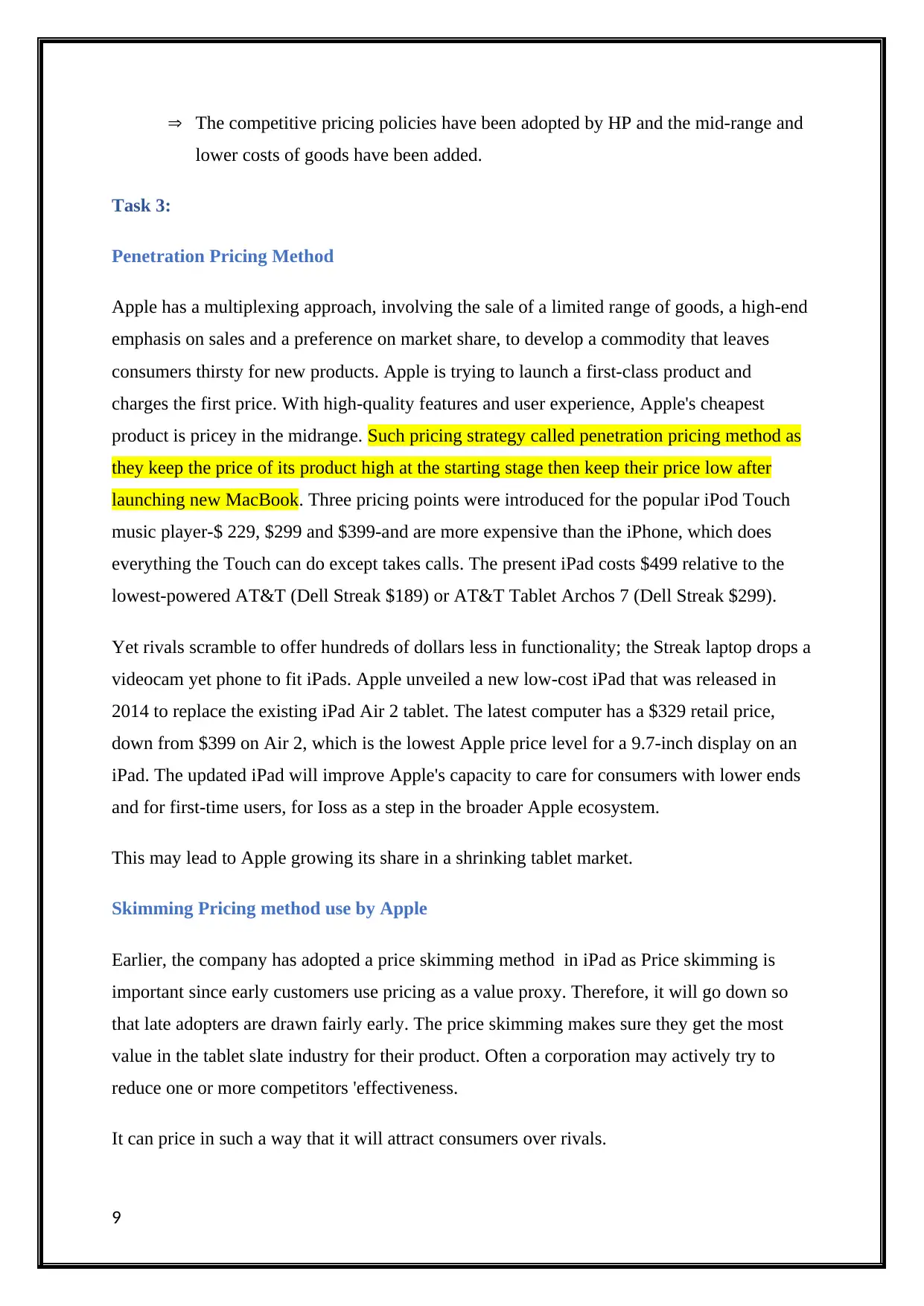
The competitive pricing policies have been adopted by HP and the mid-range and
lower costs of goods have been added.
Task 3:
Penetration Pricing Method
Apple has a multiplexing approach, involving the sale of a limited range of goods, a high-end
emphasis on sales and a preference on market share, to develop a commodity that leaves
consumers thirsty for new products. Apple is trying to launch a first-class product and
charges the first price. With high-quality features and user experience, Apple's cheapest
product is pricey in the midrange. Such pricing strategy called penetration pricing method as
they keep the price of its product high at the starting stage then keep their price low after
launching new MacBook. Three pricing points were introduced for the popular iPod Touch
music player-$ 229, $299 and $399-and are more expensive than the iPhone, which does
everything the Touch can do except takes calls. The present iPad costs $499 relative to the
lowest-powered AT&T (Dell Streak $189) or AT&T Tablet Archos 7 (Dell Streak $299).
Yet rivals scramble to offer hundreds of dollars less in functionality; the Streak laptop drops a
videocam yet phone to fit iPads. Apple unveiled a new low-cost iPad that was released in
2014 to replace the existing iPad Air 2 tablet. The latest computer has a $329 retail price,
down from $399 on Air 2, which is the lowest Apple price level for a 9.7-inch display on an
iPad. The updated iPad will improve Apple's capacity to care for consumers with lower ends
and for first-time users, for Ioss as a step in the broader Apple ecosystem.
This may lead to Apple growing its share in a shrinking tablet market.
Skimming Pricing method use by Apple
Earlier, the company has adopted a price skimming method in iPad as Price skimming is
important since early customers use pricing as a value proxy. Therefore, it will go down so
that late adopters are drawn fairly early. The price skimming makes sure they get the most
value in the tablet slate industry for their product. Often a corporation may actively try to
reduce one or more competitors 'effectiveness.
It can price in such a way that it will attract consumers over rivals.
9
lower costs of goods have been added.
Task 3:
Penetration Pricing Method
Apple has a multiplexing approach, involving the sale of a limited range of goods, a high-end
emphasis on sales and a preference on market share, to develop a commodity that leaves
consumers thirsty for new products. Apple is trying to launch a first-class product and
charges the first price. With high-quality features and user experience, Apple's cheapest
product is pricey in the midrange. Such pricing strategy called penetration pricing method as
they keep the price of its product high at the starting stage then keep their price low after
launching new MacBook. Three pricing points were introduced for the popular iPod Touch
music player-$ 229, $299 and $399-and are more expensive than the iPhone, which does
everything the Touch can do except takes calls. The present iPad costs $499 relative to the
lowest-powered AT&T (Dell Streak $189) or AT&T Tablet Archos 7 (Dell Streak $299).
Yet rivals scramble to offer hundreds of dollars less in functionality; the Streak laptop drops a
videocam yet phone to fit iPads. Apple unveiled a new low-cost iPad that was released in
2014 to replace the existing iPad Air 2 tablet. The latest computer has a $329 retail price,
down from $399 on Air 2, which is the lowest Apple price level for a 9.7-inch display on an
iPad. The updated iPad will improve Apple's capacity to care for consumers with lower ends
and for first-time users, for Ioss as a step in the broader Apple ecosystem.
This may lead to Apple growing its share in a shrinking tablet market.
Skimming Pricing method use by Apple
Earlier, the company has adopted a price skimming method in iPad as Price skimming is
important since early customers use pricing as a value proxy. Therefore, it will go down so
that late adopters are drawn fairly early. The price skimming makes sure they get the most
value in the tablet slate industry for their product. Often a corporation may actively try to
reduce one or more competitors 'effectiveness.
It can price in such a way that it will attract consumers over rivals.
9
⊘ This is a preview!⊘
Do you want full access?
Subscribe today to unlock all pages.

Trusted by 1+ million students worldwide
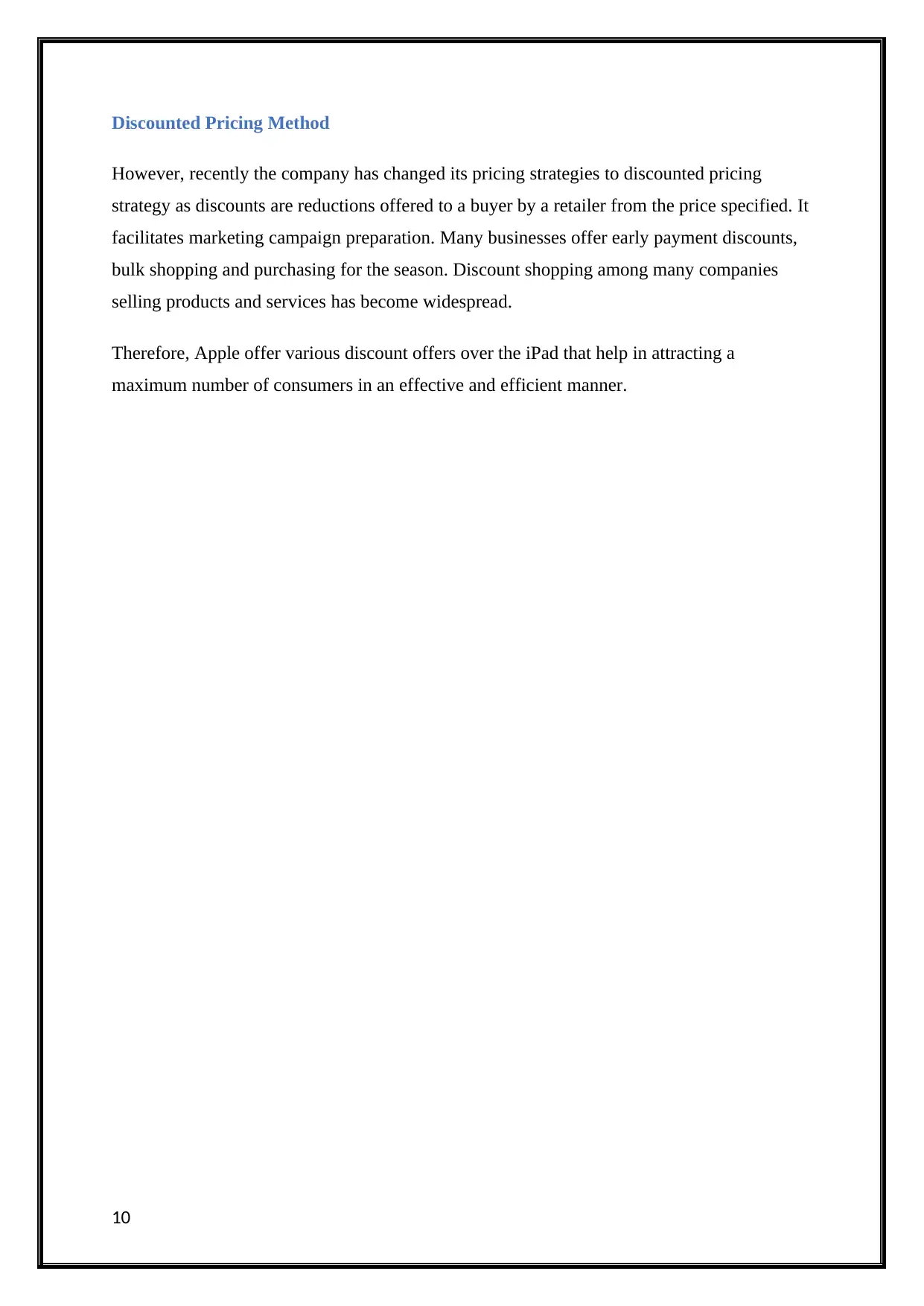
Discounted Pricing Method
However, recently the company has changed its pricing strategies to discounted pricing
strategy as discounts are reductions offered to a buyer by a retailer from the price specified. It
facilitates marketing campaign preparation. Many businesses offer early payment discounts,
bulk shopping and purchasing for the season. Discount shopping among many companies
selling products and services has become widespread.
Therefore, Apple offer various discount offers over the iPad that help in attracting a
maximum number of consumers in an effective and efficient manner.
10
However, recently the company has changed its pricing strategies to discounted pricing
strategy as discounts are reductions offered to a buyer by a retailer from the price specified. It
facilitates marketing campaign preparation. Many businesses offer early payment discounts,
bulk shopping and purchasing for the season. Discount shopping among many companies
selling products and services has become widespread.
Therefore, Apple offer various discount offers over the iPad that help in attracting a
maximum number of consumers in an effective and efficient manner.
10
Paraphrase This Document
Need a fresh take? Get an instant paraphrase of this document with our AI Paraphraser
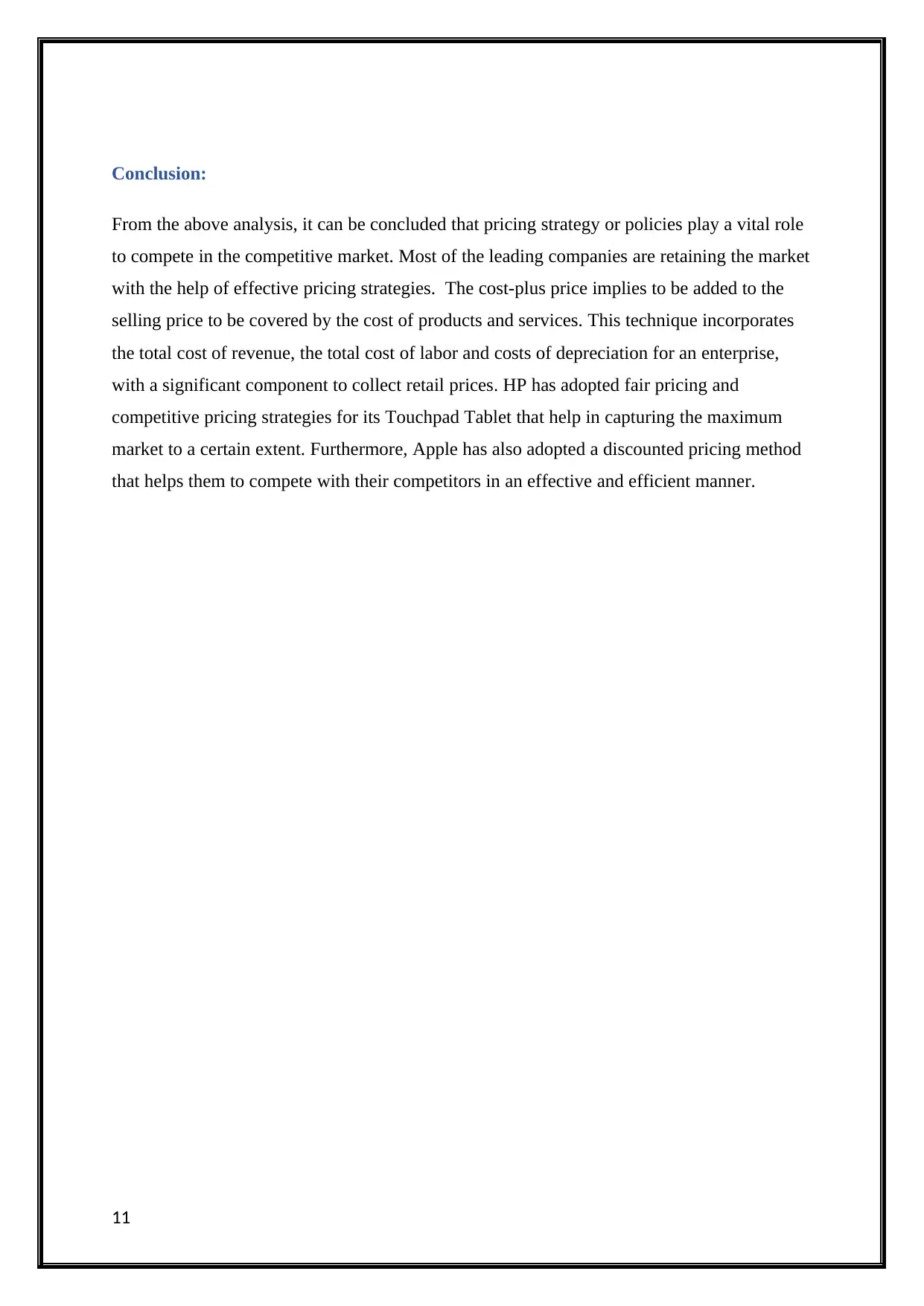
Conclusion:
From the above analysis, it can be concluded that pricing strategy or policies play a vital role
to compete in the competitive market. Most of the leading companies are retaining the market
with the help of effective pricing strategies. The cost-plus price implies to be added to the
selling price to be covered by the cost of products and services. This technique incorporates
the total cost of revenue, the total cost of labor and costs of depreciation for an enterprise,
with a significant component to collect retail prices. HP has adopted fair pricing and
competitive pricing strategies for its Touchpad Tablet that help in capturing the maximum
market to a certain extent. Furthermore, Apple has also adopted a discounted pricing method
that helps them to compete with their competitors in an effective and efficient manner.
11
From the above analysis, it can be concluded that pricing strategy or policies play a vital role
to compete in the competitive market. Most of the leading companies are retaining the market
with the help of effective pricing strategies. The cost-plus price implies to be added to the
selling price to be covered by the cost of products and services. This technique incorporates
the total cost of revenue, the total cost of labor and costs of depreciation for an enterprise,
with a significant component to collect retail prices. HP has adopted fair pricing and
competitive pricing strategies for its Touchpad Tablet that help in capturing the maximum
market to a certain extent. Furthermore, Apple has also adopted a discounted pricing method
that helps them to compete with their competitors in an effective and efficient manner.
11
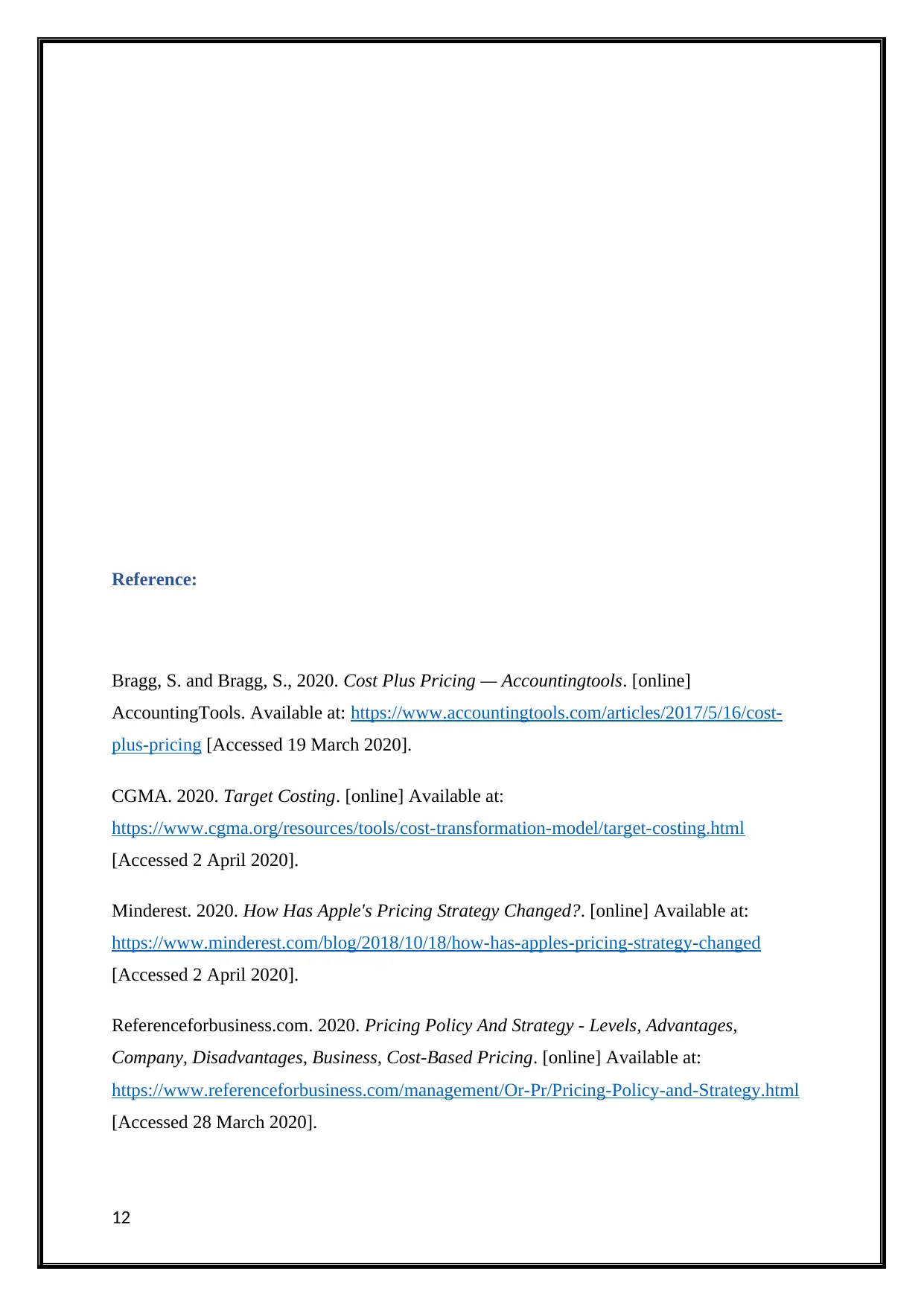
Reference:
Bragg, S. and Bragg, S., 2020. Cost Plus Pricing — Accountingtools. [online]
AccountingTools. Available at: https://www.accountingtools.com/articles/2017/5/16/cost-
plus-pricing [Accessed 19 March 2020].
CGMA. 2020. Target Costing. [online] Available at:
https://www.cgma.org/resources/tools/cost-transformation-model/target-costing.html
[Accessed 2 April 2020].
Minderest. 2020. How Has Apple's Pricing Strategy Changed?. [online] Available at:
https://www.minderest.com/blog/2018/10/18/how-has-apples-pricing-strategy-changed
[Accessed 2 April 2020].
Referenceforbusiness.com. 2020. Pricing Policy And Strategy - Levels, Advantages,
Company, Disadvantages, Business, Cost-Based Pricing. [online] Available at:
https://www.referenceforbusiness.com/management/Or-Pr/Pricing-Policy-and-Strategy.html
[Accessed 28 March 2020].
12
Bragg, S. and Bragg, S., 2020. Cost Plus Pricing — Accountingtools. [online]
AccountingTools. Available at: https://www.accountingtools.com/articles/2017/5/16/cost-
plus-pricing [Accessed 19 March 2020].
CGMA. 2020. Target Costing. [online] Available at:
https://www.cgma.org/resources/tools/cost-transformation-model/target-costing.html
[Accessed 2 April 2020].
Minderest. 2020. How Has Apple's Pricing Strategy Changed?. [online] Available at:
https://www.minderest.com/blog/2018/10/18/how-has-apples-pricing-strategy-changed
[Accessed 2 April 2020].
Referenceforbusiness.com. 2020. Pricing Policy And Strategy - Levels, Advantages,
Company, Disadvantages, Business, Cost-Based Pricing. [online] Available at:
https://www.referenceforbusiness.com/management/Or-Pr/Pricing-Policy-and-Strategy.html
[Accessed 28 March 2020].
12
⊘ This is a preview!⊘
Do you want full access?
Subscribe today to unlock all pages.

Trusted by 1+ million students worldwide
1 out of 13
Related Documents
Your All-in-One AI-Powered Toolkit for Academic Success.
+13062052269
info@desklib.com
Available 24*7 on WhatsApp / Email
![[object Object]](/_next/static/media/star-bottom.7253800d.svg)
Unlock your academic potential
Copyright © 2020–2025 A2Z Services. All Rights Reserved. Developed and managed by ZUCOL.





